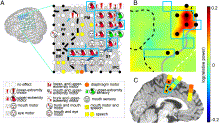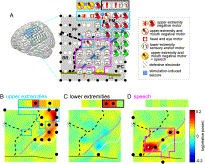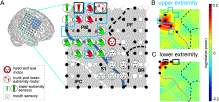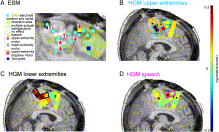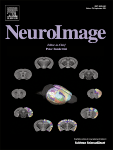Somatotopic mapping of natural upper- and lower-extremity movements and speech production with high gamma electrocorticography
- a Epilepsy Center, University Medical Center Freiburg, Freiburg, Germany
- b Neurobiology and Biophysics, Faculty of Biology, University of Freiburg, Freiburg, Germany
- c Hermann Paul School of Linguistics, Freiburg, Germany
- d Bernstein Center Freiburg, University of Freiburg, Freiburg, Germany
- Accepted 23 April 2013
- Available online 3 May 2013
Highlights
- •
High gamma ECoG responses during natural behavior exhibit a clear somatotopy.
- •
High gamma can be used to map natural upper- and lower-extremity motor functions.
- •
Exploration of natural behavior is relevant for brain-machine interfacing.
Abstract
Precise delineation of pathological and eloquent cortices is essential in pre-neurosurgical diagnostics of epilepsy. A limitation of existing experimental procedures, however, is that they critically require active cooperation of the patient, which is not always achievable, particularly in infants and in patients with insufficient cognitive abilities. In the present study, we evaluated the potential of electrocorticographic recordings of high gamma activity during natural, non-experimental behavior of epilepsy patients to localize upper- and lower-extremity motor and language functions, and compared the results with those obtained using electrocortical stimulation. The observed effects were highly significant and functionally specific, and agreed well with the somatotopic organization of the motor cortex, both on the lateral convexity and in the supplementary motor area. Our approach showed a similar specificity and sensitivity for extremity movements as previously obtained from experimental data. We were able to quantify, for the first time, sensitivity and specificity of high gamma underlying non-experimental lower-extremity movements in four patients, and observed values in the same range as for upper extremities (analyzed in six patients). Speech-related responses in the three investigated patients, however, exhibited only a very low sensitivity. The present findings indicate that localization of not only upper- but also lower-extremity movements congruent with electrocortical stimulation mapping is possible based on event-related high gamma responses that can be observed during natural behavior. Thus, non-experimental mapping may be usefully applied as adjunct to established clinical procedures for identification of both upper- and lower-extremity motor functions.
Keywords
- Epilepsy surgery;
- Eloquent cortex;
- Electrocortical stimulation mapping;
- ECoG;
- High gamma;
- Motor cortex
Figures and tables from this article:

Fig. 1. Examples of natural movements analyzed to map the motor cortex. Frequent arm movements identified in the video recordings of P5 were object-directed movements such as grasping (A, B) and object manipulation such as holding the telephone cord (C). The images are cropped from the ECoG-synchronized video recordings used for the selection of natural movements and speech production events. The field of view of the video cameras encompassed the whole bed of the patients.
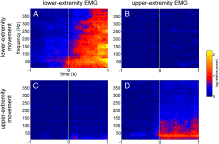
Fig. 2. Validation of video-based identification of natural movements. Trial-averaged relative power spectra of the (A) lower-extremity EMG (quadriceps muscle) but not (B) upper-extremity EMG (deltoid muscle) showed a clear power increase during lower-extremity movements. (C) and (D) same as (A) and (B) but for upper-extremity trials. The vertical line at 0 s corresponds to the movement onset identified in the video data.

